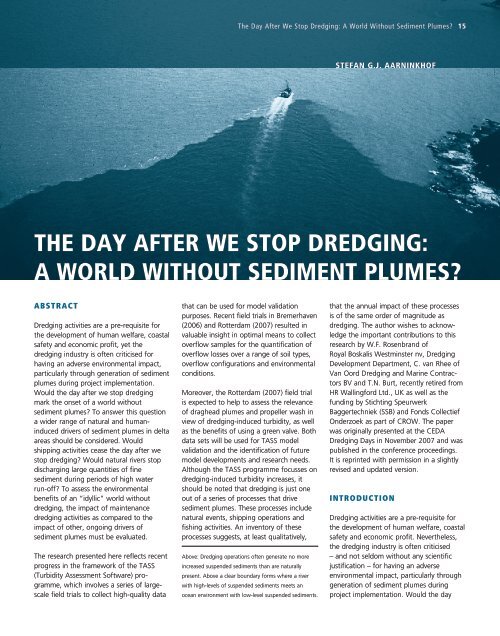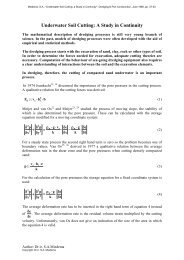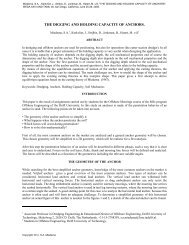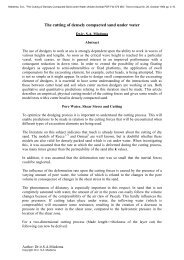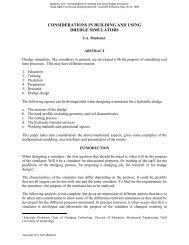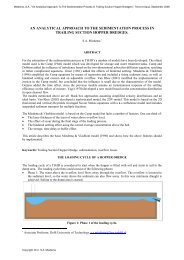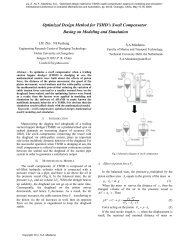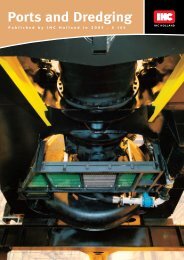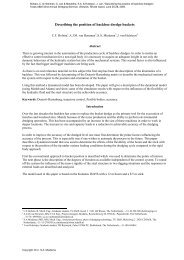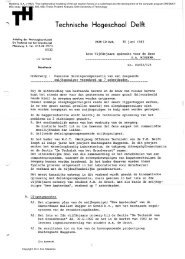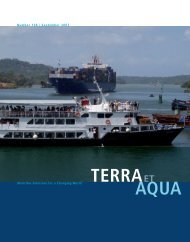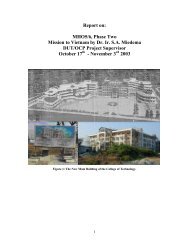14 Terra et Aqua | Number 110 | March 2008Progress in the execution of safety policiesis monitored on a quarterly basis. Becauseof the large amount of work, a safetyofficer is appointed on every sizeableproject. This inspector safeguards a highsafety level. In the past few years, whileturnover has been growing, the numberof accidents has been declining.All Van Oord ships over 500 GT arecertified according to the ISM Code incompliance with international legislation.This means that these ships meet theinternational standards for ship managementsafeguarding safety at sea andpreventing damage to property and theenvironment.<strong>The</strong>se vessels are frequently inspected byVan Oord auditors as well as auditors froman external agency. Given this closeattention to safety standards, choosing oneproject over another for an award takescareful consideration.In 2006, acknowledging the maximumeffort put into safety and security measureswhile working in an extraordinarily challengingenvironment, Van Oord Nigeria Ltdwas presented with the Hansje BrinkerAward for its overall achievements(Figures 1 and 2).<strong>The</strong> award recognised three Nigerian projectsites, a well-equipped maintenanceyard in Port Harcourt and the branch officein Lagos. One of the projects was thedredging for the creation of an artificiallake, “Lake Tinapa”, which is part of aworld-class integrated business resortcomplex being constructed on the banks ofthe Calabar River. Tinapa is located northof Calabar, eastern Nigeria’s main port.Some 885,000 m 3 soil has been removedwith a cutter suction dredger and the soilhas been efficiently reused to create newland for future leisure development.A second project is at Calabar, easternNigeria’s main port, which is situated83 km up the Calabar River in the NigerDelta. Nestled in the far southeast ofNigeria, Cross River State is Nigeria’sfrontier to Cameroon, Sao Tome, EquatorialGuinea and beyond. <strong>The</strong> seaport, namedFigure 1. At the awards presentation, Safety OfficerJ. Ogbo accepts the Hansje Brinker Award fromKoos van der Geer on behalf of Van Oord Nigeria, Ltd.Calabar New Port, has an array of modernfacilities for the export and import trade.Between 1976 and 1995 Van Oord carriedout several projects in the vicinity, includingrecently the maintenance of the CalabarChannel for National Ports Authority.<strong>The</strong> award-winning project involved theupstream dredging of the access channelto Calabar New Port being done by twotrailing suction hopper dredgers, which aredeepening the channel from -7 m to -10 mover a width of 150 m and a length of46 km. This will allow vessels with a lengthof 170 m and a deadweight of between10,000 and 15,000 tonnes to safely reachthe port. <strong>The</strong> estimated volume of sedimentto be dredged is 12,750,000 m 3 . <strong>The</strong>dredged material is placed in allocateddisposal areas.All these projects have been supportedby the yard at Port Harcourt. Generallyspeaking, Nigeria is not an easy countryto work and so winning this award wasa significant accomplishment.<strong>The</strong> standards of health and safety managementdemanded in Nigeria were nodifferent than those required by otherVan Oord projects. In fact, the difficultcircumstances created an optimumawareness by all employees both nationaland expatriate staff. Oil and gas standardsalso enhanced a high level of safety andsecurity morale.Amongst the safety measures consideredwere the Toolbox meetings which occuralmost daily somewhere in Nigeria. ToolboxFigure 2. A Toolbox meeting in progress: <strong>The</strong>y are anessential aspect of the stringent safety measures andoccur almost daily somewhere in Nigeria.meetings are brief meetings at which(near-) accidents, HSE (health, safety,environment) news and special subjects, arediscussed in relation to relevant activities(vessel-specific, project-specific or yardspecific).Safety walks, audits and implementationof consequential measures are aday-to-day activity. Van Oord Nigeria Ltd.also regularly undergoes external audits.<strong>The</strong> Van Oord Community Relations Plansafeguards a good relationship with theindigenous host communities at worksitesand offices throughout the country.In addition, a major focus is on medicalcare. <strong>The</strong> high safety standard withinVan Oord Nigeria features the presence ofan ambulance, a doctor and clinic fromSOS International at all project offices.<strong>The</strong> healthcare standards and Medivacarrangements are optimised through anSOS International contract wherebyhelicopter service can be rendered ondemand and present at site within aminimum time frame. <strong>The</strong> SOS clinic in PortHarcourt renders service for the expatriatestaff, while two audited retainer hospitalsprovide care for the Nigerian staff.In a brief overview: Van Oord Nigeria had459,000 work-hours, with 310 toolboxmeetings, 23 safety inspections and/oraudits, 5 safety checks by independentorganisations and only 1 accident thatresulted in absence. <strong>The</strong> LIFR, number ofLost Time Injuries per 1,000,000 workhours, was a minimal 2.18. All in all thesenumbers testify to the heightened safetyawareness at Van Oord Nigeria.
<strong>The</strong> Day After We Stop <strong>Dredging</strong>: A World Without Sediment Plumes? 15STEFAN G.J. AARNINKHOFTHE DAY AFTER WE STOP DREDGING:A WORLD WITHOUT SEDIMENT PLUMES?ABSTRACT<strong>Dredging</strong> activities are a pre-requisite forthe development of human welfare, coastalsafety and economic profit, yet thedredging industry is often criticised forhaving an adverse environmental impact,particularly through generation of sedimentplumes during project implementation.Would the day after we stop dredgingmark the onset of a world withoutsediment plumes? To answer this questiona wider range of natural and humaninduceddrivers of sediment plumes in deltaareas should be considered. Wouldshipping activities cease the day after westop dredging? Would natural rivers stopdischarging large quantities of finesediment during periods of high waterrun-off? To assess the environmentalbenefits of an “idyllic” world withoutdredging, the impact of maintenancedredging activities as compared to theimpact of other, ongoing drivers ofsediment plumes must be evaluated.<strong>The</strong> research presented here reflects recentprogress in the framework of the TASS(Turbidity Assessment Software) programme,which involves a series of largescalefield trials to collect high-quality datathat can be used for model validationpurposes. Recent field trials in Bremerhaven(2006) and Rotterdam (2007) resulted invaluable insight in optimal means to collectoverflow samples for the quantification ofoverflow losses over a range of soil types,overflow configurations and environmentalconditions.Moreover, the Rotterdam (2007) field trialis expected to help to assess the relevanceof draghead plumes and propeller wash inview of dredging-induced turbidity, as wellas the benefits of using a green valve. Bothdata sets will be used for TASS modelvalidation and the identification of futuremodel developments and research needs.Although the TASS programme focusses ondredging-induced turbidity increases, itshould be noted that dredging is just oneout of a series of processes that drivesediment plumes. <strong>The</strong>se processes includenatural events, shipping operations andfishing activities. An inventory of theseprocesses suggests, at least qualitatively,Above: <strong>Dredging</strong> operations often generate no moreincreased suspended sediments than are naturallypresent. Above a clear boundary forms where a riverwith high-levels of suspended sediments meets anocean environment with low-level suspended sediments.that the annual impact of these processesis of the same order of magnitude asdredging. <strong>The</strong> author wishes to acknowledgethe important contributions to thisresearch by W.F. Rosenbrand ofRoyal Boskalis Westminster nv, <strong>Dredging</strong>Development Department, C. van Rhee ofVan Oord <strong>Dredging</strong> and Marine ContractorsBV and T.N. Burt, recently retired fromHR Wallingford Ltd., UK as well as thefunding by Stichting SpeurwerkBaggertechniek (SSB) and Fonds CollectiefOnderzoek as part of crow. <strong>The</strong> paperwas originally presented at the CEDA<strong>Dredging</strong> Days in November 2007 and waspublished in the conference proceedings.It is reprinted with permission in a slightlyrevised and updated version.INTRODUCTION<strong>Dredging</strong> activities are a pre-requisite forthe development of human welfare, coastalsafety and economic profit. Nevertheless,the dredging industry is often criticised– and not seldom without any scientificjustification – for having an adverseenvironmental impact, particularly throughgeneration of sediment plumes duringproject implementation. Would the day


